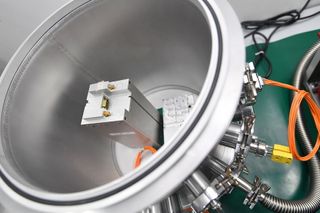Inmarsat & AVI's Satellite Data-Relay Service Exits Stealth Mode After Months of Secret, In-Space Tests

SAN FRANCISCO — For more than a year, mobile satellite services provider Inmarsat has been working with Addvalue Innovation (AVI), a communications technology company based in Singapore, to conduct secret tests of a service that lets operators maintain continuous contact with small satellites in low Earth orbit. Now, the companies are ready to offer the Inter-satellite Data Relay Service (IDRS) to satellite operators.
"We are excited about this opportunity because strategically it opens a new market sector for us," Peter Dingley, Inmarsat vice president for future government technologies, told SpaceNews. "With just three satellites in geosynchronous orbit we can see these small satellites as they are spinning around Earth constantly and communicate with them."

Commercial satellite operators typically communicate with satellites in low Earth orbit through ground stations. Often, that means operators gather information and send instructions during a period that lasts from 15 to 20 minutes per orbit.
"Our service provides them with the ability to take a quick look at something that might be happening and then act based on the information exchanged," Dingley said.
IDRS is the brainchild of Khai Pang Tan, chief operating and technology officer for AVI, a subsidiary of Addvalue Technologies Ltd. In 2012, Tan realized that the problem of communicating with satellites in low Earth orbit could be solved if operators could relay data through the Inmarsat-4 constellation of geosynchronous L-band communications satellites and Inmarsat's Broadband Global Area Network (BGAN). Because AVI was already an authorized developer for Inmarsat BGAN mobile satellite terminals, engineers redesigned the terminals to reduce their size and make them durable enough to survive spaceflight. [Satellite Quiz: What's Up There?]
The first IDRS L-band terminal, which fits in a two-unit cubesat and includes a primary and a backup transceiver, was launched in December 2015 on the Velox-2 satellite developed by AVI and Singapore's Nanyang Technological University with funding provided by the Singapore Economic Development Board's Office of Space Technology and Innovation.
For more than a year, AVI has sent instructions to the Velox-2 satellite, a 13-kilogram, six-unit cubesat, through the Inmarsat-4 constellation. "We were even able to upload firmware to the IDRS transceiver, which means operators could configure satellites for different missions on the fly," Tan told SpaceNews. "We hope this will have a game-changing effect on low-Earth-orbit operations."
Get the Space.com Newsletter
Breaking space news, the latest updates on rocket launches, skywatching events and more!
Inmarsat and AVI have not discussed the project until now.
"This reflects Inmarsat's very conservative approach to the market," Dingley said. "We like to know that when we offer service in the marketplace, we have done a considerable amount of testing and proving to make sure we are able to maintain our reputation as the trusted supplier with very high grade communications. We are now sufficiently confident to take this to full commercial service."
AVI is meeting with satellite manufacturers, including Airbus Defence and Space and Surrey Satellite Technologies Ltd., and offering to integrate IDRS terminals with their buses. "We are going to provide the hardware and engineering services," Tan said.
Once the new satellites are launched into orbit, Inmarsat will offer commercial and government customers direct access to their satellites through BGAN, which also provides communications links for trucks, ships and aircraft. "It's moving a little faster than some of our platforms, but it looks like another mobile platform that connects to our network," Dingley said.
AVI and Inmarsat have signed a memorandum of understanding giving AVI "exclusive rights to distribute airtime for the terminals it provides," Tan said. "We will provide almost a one-stop shop for satellite operators."
IDRS customers will purchase communications services for their satellites the same way individuals buy data packages for mobile devices. Fees for the packages vary based on the amount of data operators exchange with their satellites per month, Dingley said.

Typical IDRS customers will seek communications services for three, five or seven satellites. The new service is not well suited for constellations with hundreds of satellites nor for Earth observation missions due to the extensive volume of communications they require, Dingley said.
"We are not trying to replicate the very high capacity links that the surveillance satellites or Earth science satellites need because they download a huge amount of information," Dingley said. "What we can do with our service is provide real-time command and control so that people can actually interrogate and retask the satellites during their orbit."
For example, an operator could redirect a satellite's infrared or visible light camera or send instructions to other onboard instruments, Dingley said.
Nations that are beginning to develop space programs also are showing keen interest in the IDRS because the ongoing interaction will help operators become more familiar with satellites and onboard instruments, Dingley said. Without this type of service, operators would send instructions and then wait one to two hours before finding out how the satellite executed those instructions. The satellite would then disappear again while people thought about what had happened. An hour to two hours later, they would tell the satellite to do something different, he added.
IDRS is not the only new communications service for satellites in low Earth orbit. Spaceflight Industries is installing high-throughput antennas around the world to offer internet access to imagery. Solstar Space Co. of Santa Fe, New Mexico, plans to offer communications links for astronauts and machines in space. Audacy, a Silicon Valley startup, is raising money to establish a commercial constellation of communications relay satellites in medium Earth orbit.
As far as Tan knows, Inmarsat and Addvalue are offering the first commercial relay service for satellites in low Earth orbit. "I would say we are the first one," he said. "And we have the head start."
Comments: werner.debra@gmail.com
This story was provided by SpaceNews, dedicated to covering all aspects of the space industry.
Join our Space Forums to keep talking space on the latest missions, night sky and more! And if you have a news tip, correction or comment, let us know at: community@space.com.
Debra Werner is a correspondent for SpaceNews based in San Francisco. She earned a bachelor’s degree in communications from the University of California, Berkeley, and a master’s degree in journalism from Northwestern University. Debra is a recipient of the 1989 Gerald Ford Prize for Distinguished Reporting on National Defense. Her SN Commercial Drive newsletter is sent out on Wednesdays.
Most Popular


